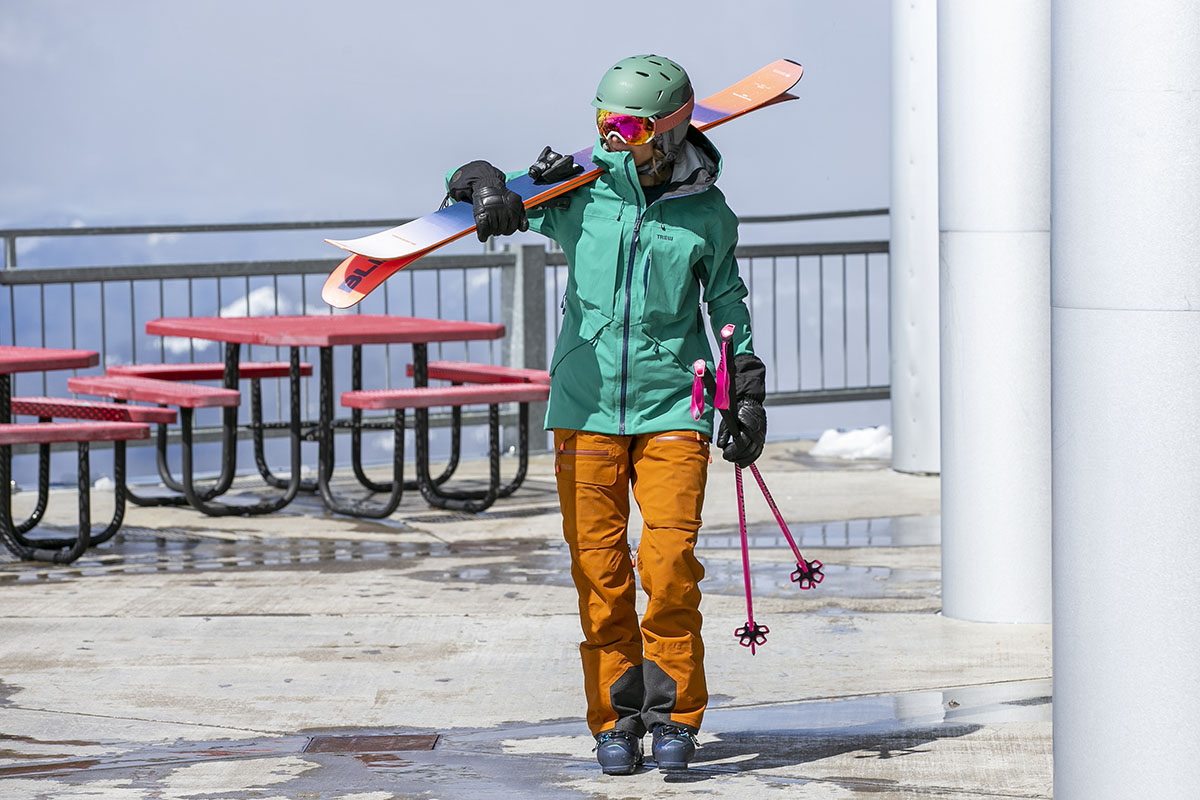
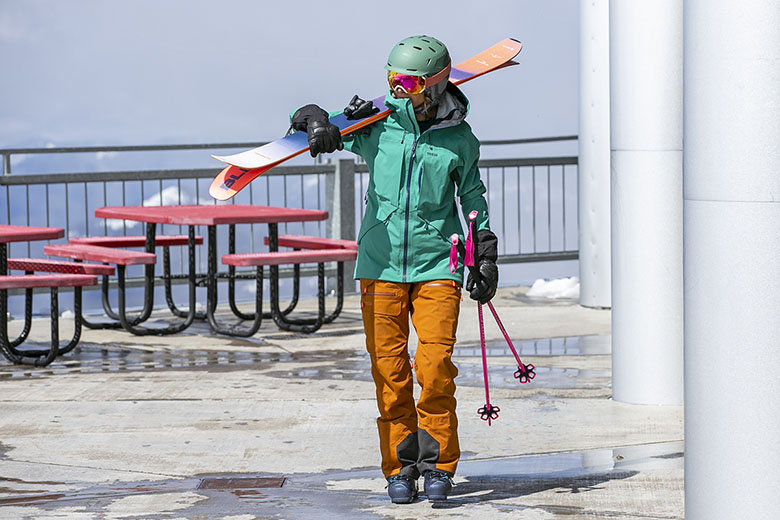
Switchback Travel (Jon Tapper)
Price: $499
Weight: 1 lb. 10.8 oz. (size small)
Waterproofing: 3L PNW Primo
What we like: Stalwart protection and excellent durability in a stylish package.
What we don’t: Fairly heavy, bulky, and lacking in breathability for regular backcountry use.
See the Women's Stella Jacket Primo See the Men's Cosmic Jacket Primo
Oregon-based Trew Gear is no stranger to inclement weather, and their ski jackets are built to handle harsh conditions and rough treatment while looking good in the process. The women’s-specific Stella Jacket Primo is a case in point, combining trustworthy protection and highly durable fabrics in a modern and stylish package. It’s a little heavy, bulky, and lacking in breathability for deep backcountry use, but resort-goers that explore the whole mountain will find few compromises. Below we outline our experiences with the Stella Jacket Primo. To see how it stacks up to the competition, see our articles on the best women’s ski jackets and best women's snowboard jackets.
The Pacific Northwest is notorious for its frequently inclement weather, and Trew Gear covered all the bases with their Stella Jacket Primo. For starters, the jacket uses the brand’s in-house 3-layer PNW Primo membrane that puts up a solid defense against everything from rain and sleet to wet, heavy snow and relentless wind. You also get a durable water repellent (DWR) coating that helps moisture bead up and roll off the exterior rather than soak through, as well as fully taped seams for added assurance. In testing, the Stella Jacket Primo performed flawlessly throughout one of the stormiest winters in recent memory.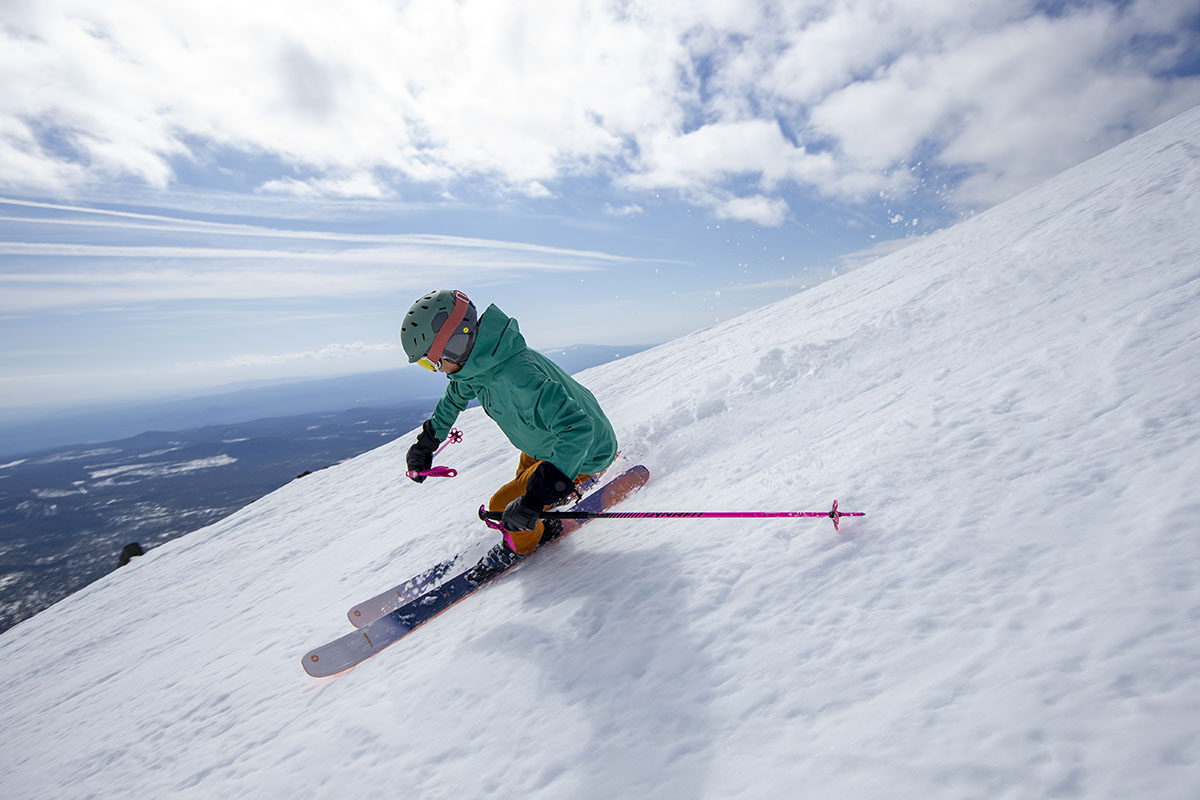
In addition to its reliable construction, the Stella Jacket Primo makes it easy to batten down the hatches with plenty of protective features. First, all of the zippers are highly water-resistant, and the five exterior pockets boast fabric flaps for an extra line of defense against moisture. The main zipper also features a “garage” at the top to prevent water from seeping into the teeth. Further, the helmet-compatible hood is highly adjustable, offers great coverage, and includes a stiff brim to keep droplets out of your face. I also love the tall collar, which provides a nice reprieve in rough and rowdy weather. Finally, the hem extends just below my hips, and the sleeves reach halfway down my hands with hook-and-loop closures to seal out moisture at the wrists. The flared cuffs are a little polarizing in terms of looks, but the Stella Jacket Primo leaves little to be desired from a protection standpoint.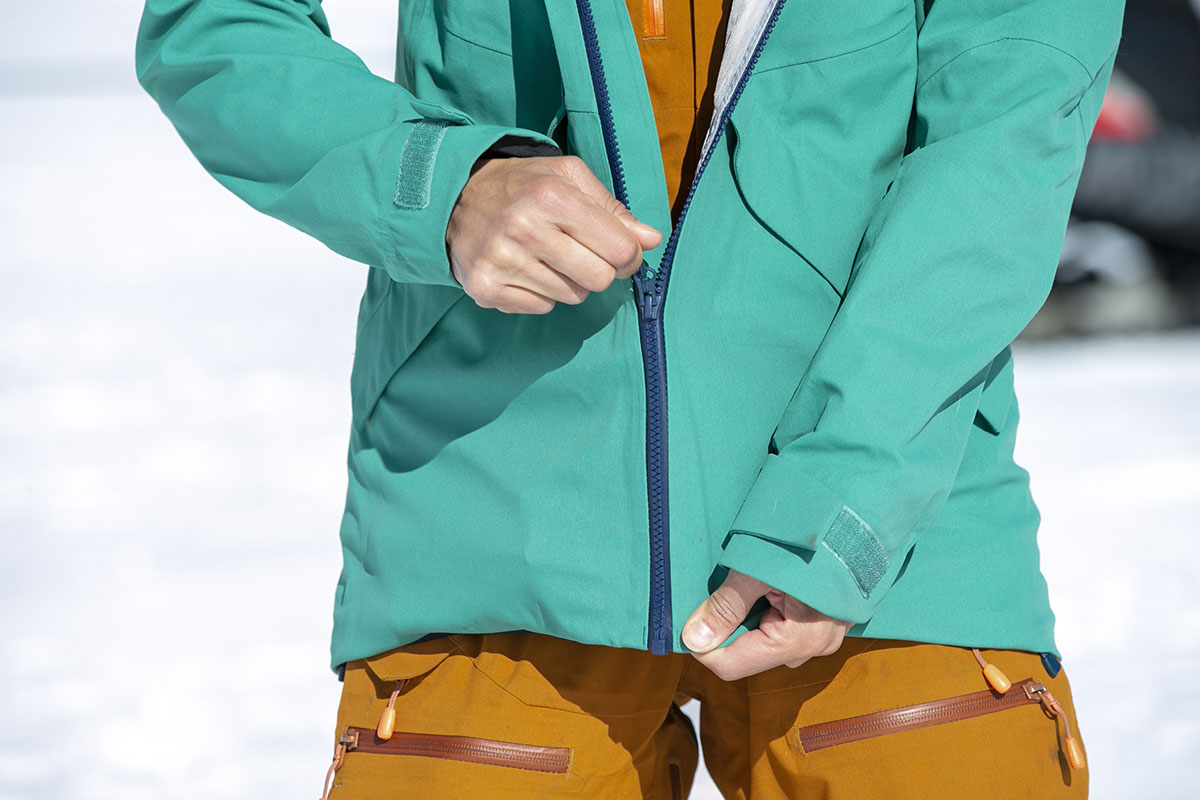
Unfortunately, the Stella Jacket Primo’s excellent weather protection comes at the cost of breathability. Most resort-goers shouldn’t mind this trade-off, especially on frigid chairlift rides when wind blocking is the top priority, but backcountry skiers expending significant energy on the skin track will likely be disappointed. To be fair, you do get sizable (16-in.) pit zips for dumping excess heat, which were effective at keeping me comfortable on early spring days and short bootpacks to Mt. Bachelor’s summit bowls. But for high-output tours that require working hard for extended stretches, there are plenty of more breathable options to consider. A few of our favorites are the Outdoor Research Skytour, Black Diamond Recon Stretch, and Dynafit Beast Hybrid (the final option is a softshell that’s not completely waterproof).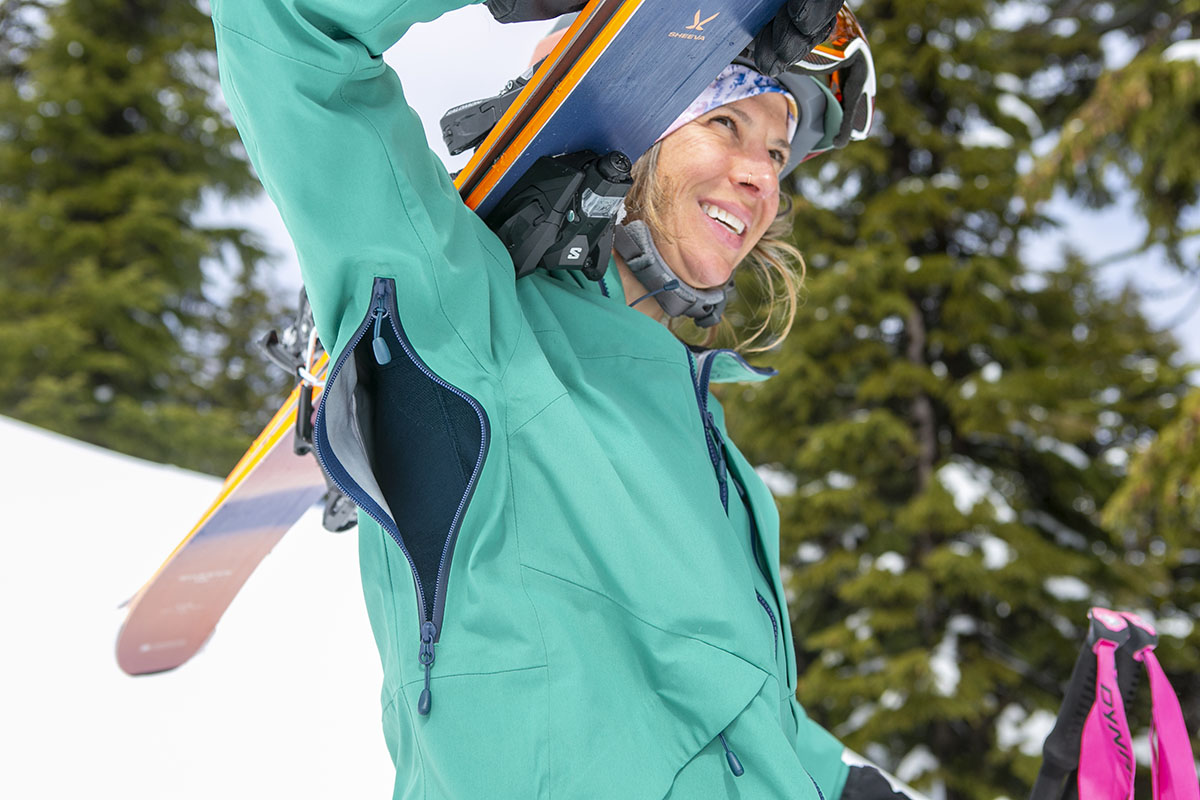
Trew Gear focuses most of their efforts at the premium end of the ski outerwear market, and the Stella Jacket Primo is a clear reflection of their expertise. For reference, I put the jacket through the wringer last season: I stuffed it inside my pack and roof box, threw it in the back of my car with sharp gear, and brushed up against protruding branches while zipping through tight glades. Despite the abuse, the burly woven nylon construction held up incredibly well with no signs of wear to date—there are no tears, signs of pilling, or loose threads. All of the smaller components are faring equally well, from the hood and hem drawcords to the smooth-operating main zipper. The jacket maintained its waterproofing abilities throughout testing, too, with no noticeable deterioration. Given these experiences, I expect the Stella Jacket Primo will have a long and healthy lifespan. 
My women’s small Stella Jacket Primo clocked in at 1 pound 10.8 ounces on my scale, which is 1.8 ounces higher than Trew Gear’s listed weight (for a size medium) and fairly heavy for dedicated backcountry use. For comparison, you can shave off a good amount of weight with touring-ready designs like the Outdoor Research Skytour AscentShell Jacket (1 lb. 4.3 oz.) or Flylow Gear Lucy Jacket (1 lb. 3.5 oz.), and the Ortovox 3L Ortler—which is my go-to guiding jacket—is substantially lighter at just 13.4 ounces. Even the Norrøna Tamok, which uses top-end Gore-Tex Pro waterproofing and comes decked out with ski-ready features, weighs slightly less at 1 pound 8.4 ounces.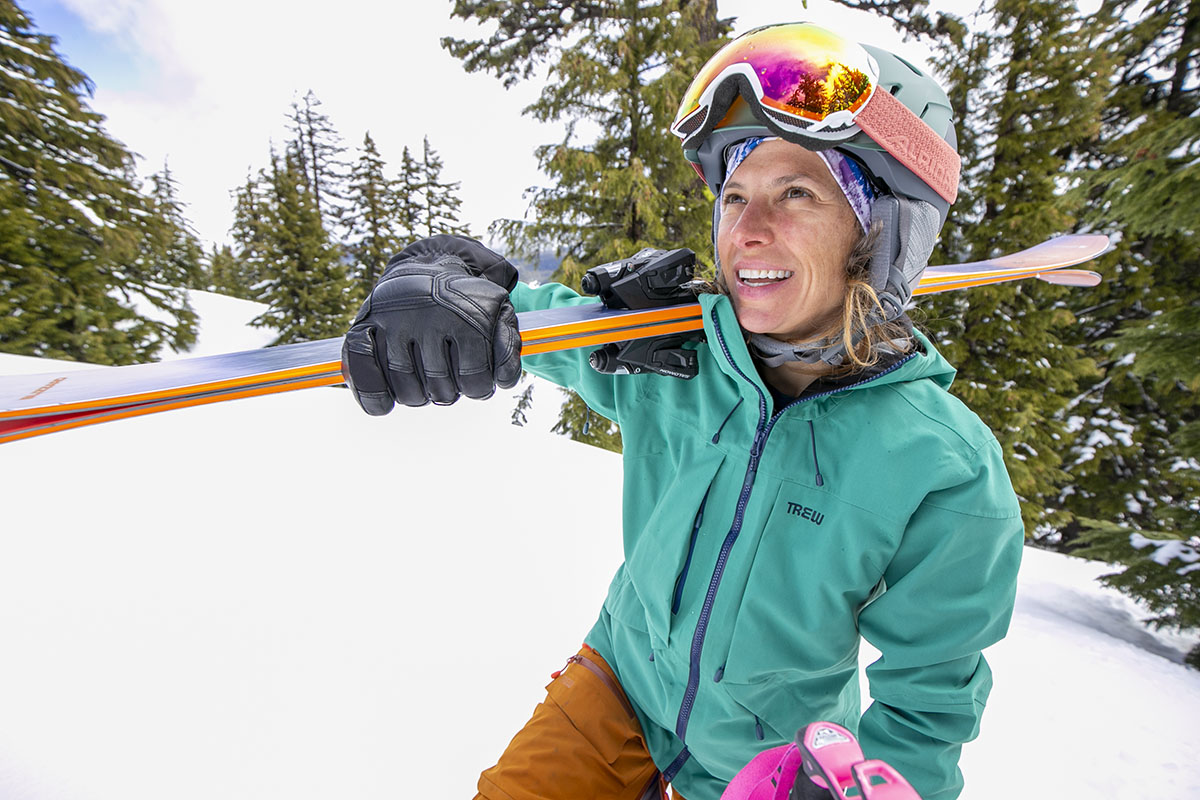
Weight and packability almost always go hand in hand, and the Stella Jacket Primo is no exception. Stuffed into its hood, the package is large enough that it’s not practical for cramming into my ski backpack regularly. Again, the higher weight and larger packed size aren’t dealbreakers for resort use, and the Stella is perfectly serviceable for the occasional tour. But for skiers who spend more time in the backcountry than inbounds, we’d recommend going with something lighter and less bulky.
Hood design can make or break a ski jacket, and Trew Gear landed on a great one with the Stella Jacket Primo. The full-coverage design is helmet-compatible and comfortably fits over my Smith Nexus MIPS without any restriction to movement or vision, and the stiff brim does a great job at deflecting precipitation while maintaining its shape even in heavy winds and rain. It’s also easy to adjust with three drawcords—one at the rear and two at the front—for dialing in fit. With the jacket fully zipped and the hood cinched tight, the Stella left only my goggles and the tip of my nose exposed to the elements. I did find loosening the rear drawcord to be a little tricky with gloves on, but it’s certainly doable with some practice and patience (removing your gloves will speed things up). Finally, there's a hidden Recco reflector in the brim that adds a nice dose of security in the event of a backcountry emergency.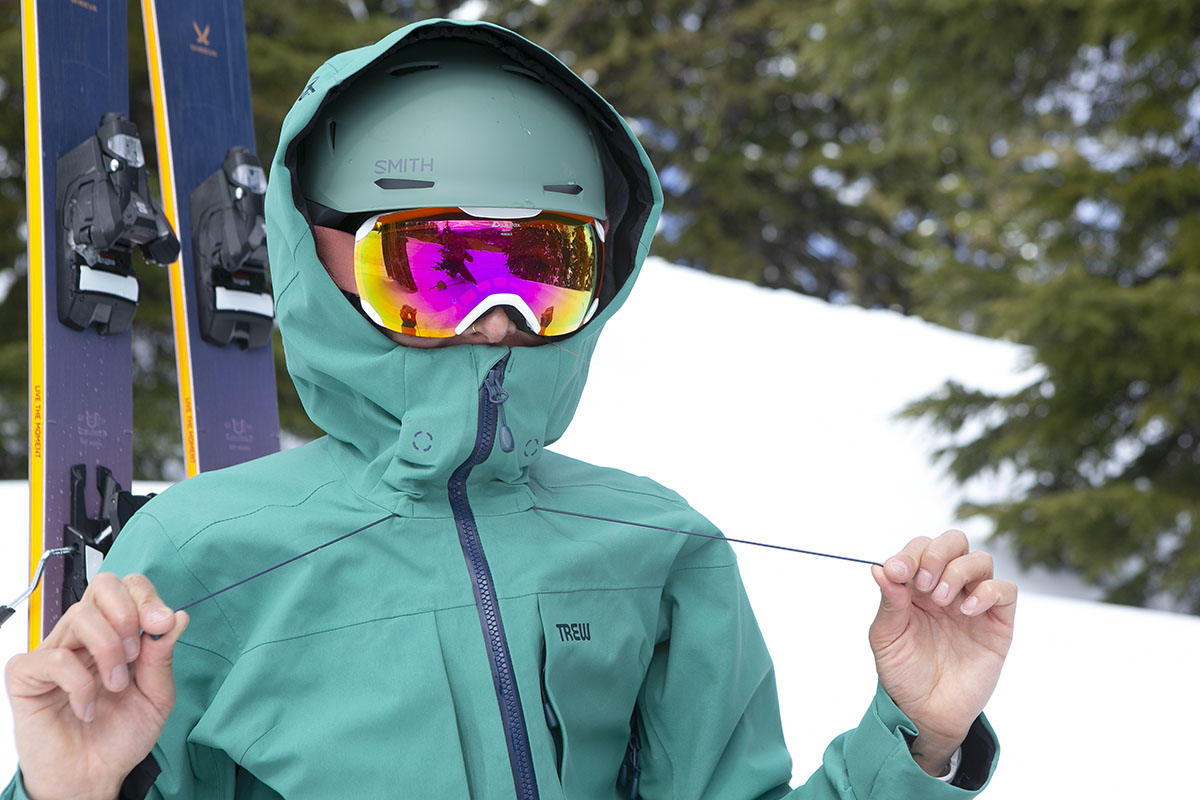
The Stella Jacket Primo’s storage layout is arguably one of its biggest strong suits: With seven total pockets, there’s no shortage of space for stashing the essentials. Starting at the outside, you get two deep hand pockets with angled openings that add to the sleek and polished exterior, as well as dual chest pockets that are plenty big for storing electronics or snacks for the day. The left chest pocket also boasts an inner mesh sleeve for keeping your phone separate, as well as a port through which you can route headphone cords. A dedicated ski pass pocket on the left forearm rounds out the exterior layout. Importantly, all of the aforementioned pockets feature water-resistant zippers and fabric flaps for sealing out moisture. Finally, you get two mesh shove-it pockets inside that are great for climbing skins, gloves, or a beanie.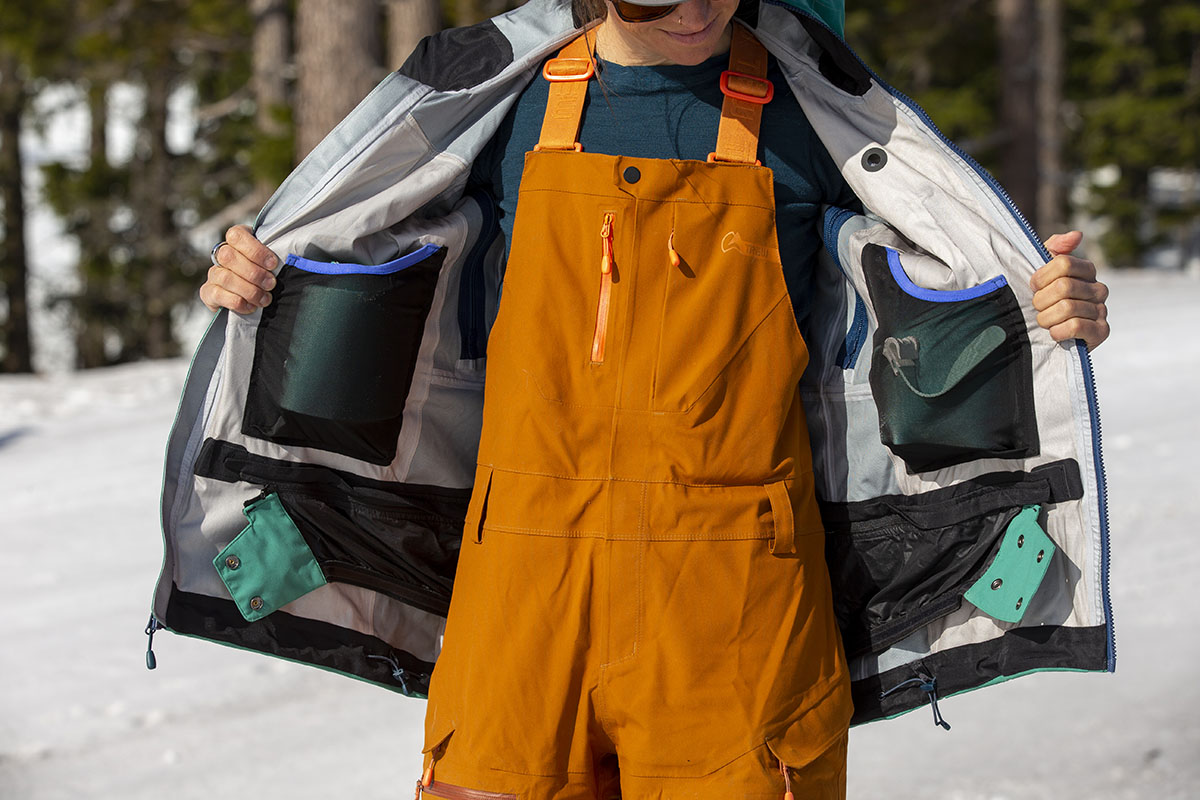
Like most modern ski jackets, the Stella Jacket Primo has a powder skirt that’s designed to keep moisture out when skiing deep snow or in the event of a fall. The design is fairly standard: The skirt features grippy elastic around the perimeter to keep it in place, with snaps at the front to secure it shut. Unlike many competitors, the Stella’s skirt can’t be attached to compatible ski pants, but I do love that it’s easily removable via an internal zipper—great for spring groomer laps or mild-weather tours when you want to keep weight to a minimum. To be sure, a powder skirt isn’t a requisite feature for many riders (ski bibs can accomplish the same goal), but it’s nevertheless a great extra line of defense on powder days.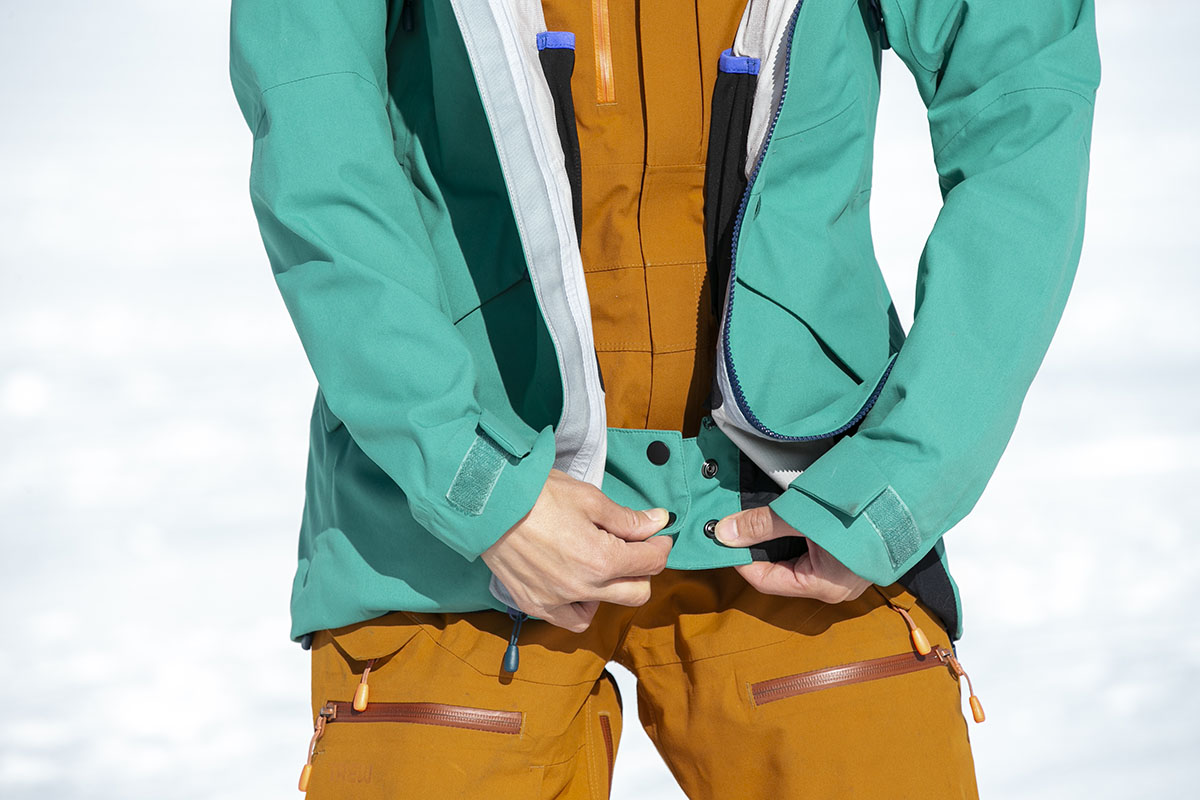
The Stella Jacket Primo boasts Trew Gear’s women’s-specific “modern freeride fit,” which is relaxed with a long cut and sleeves that maximize coverage. Since I personally prefer a more accommodating fit—for layering generously underneath when needed and added mobility when wrangling snowmobiles—I opted for a women’s small (I’m on the lower end of the range according to their sizing chart). The fit and sizing worked well for me: The jacket is roomy enough for layering without feeling overly baggy, the sleeves reach just past my wrists, and the hem extends below my hips for coverage when sitting down or bending over. Women who are between sizes or who prefer a slim cut will likely want to size down, but I never felt like the Stella was too much jacket. Finally, while largely subjective, I love the modern freeride styling and sleek looks, which are Trew Gear hallmarks.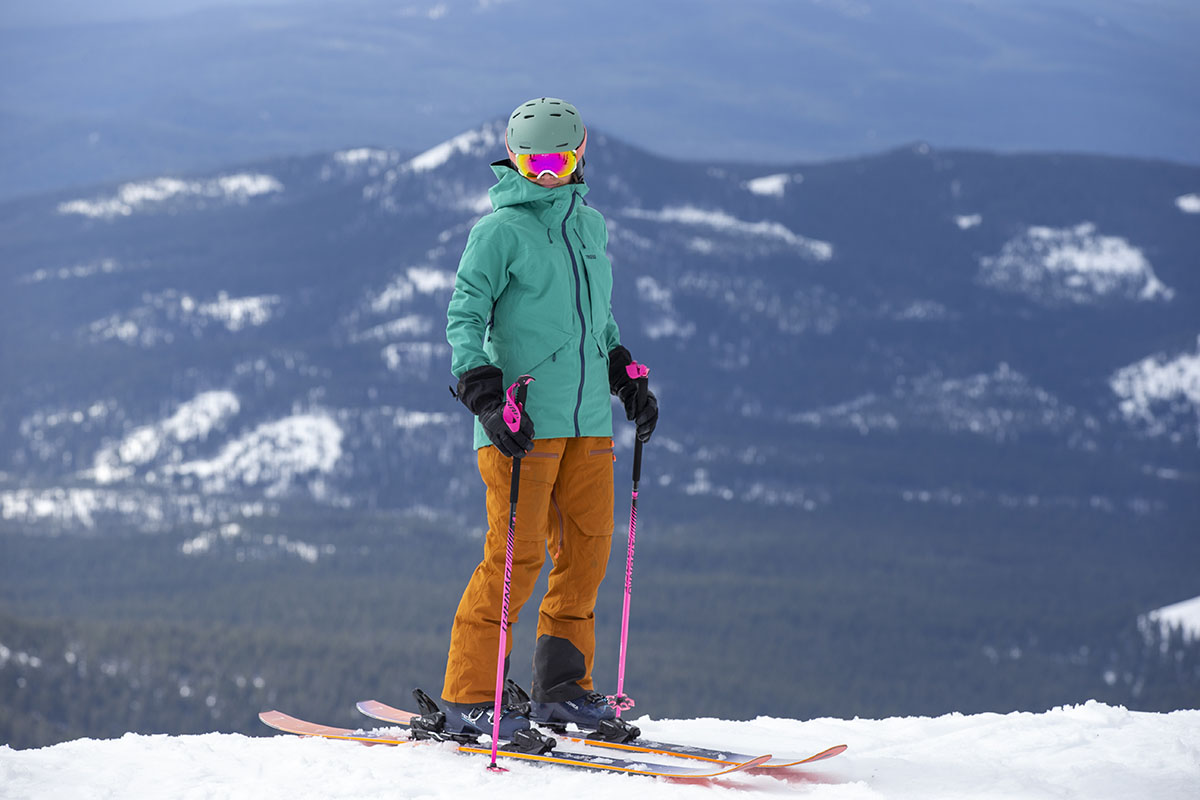
We appreciate when brands go the extra mile in creating sustainable products, and the Stella Jacket Primo is a solid effort from Trew Gear. First, the shell fabric is made from 100%-recycled nylon. Second, the jacket is bluesign-approved, which means it’s made without the use of harmful chemicals and has been deemed safe for workers, consumers, and the environment. We’d love to see a PFC-free DWR coating and/or certification to the Fair Trade standard in a future update, but we nevertheless appreciate the steps the brand has taken thus far.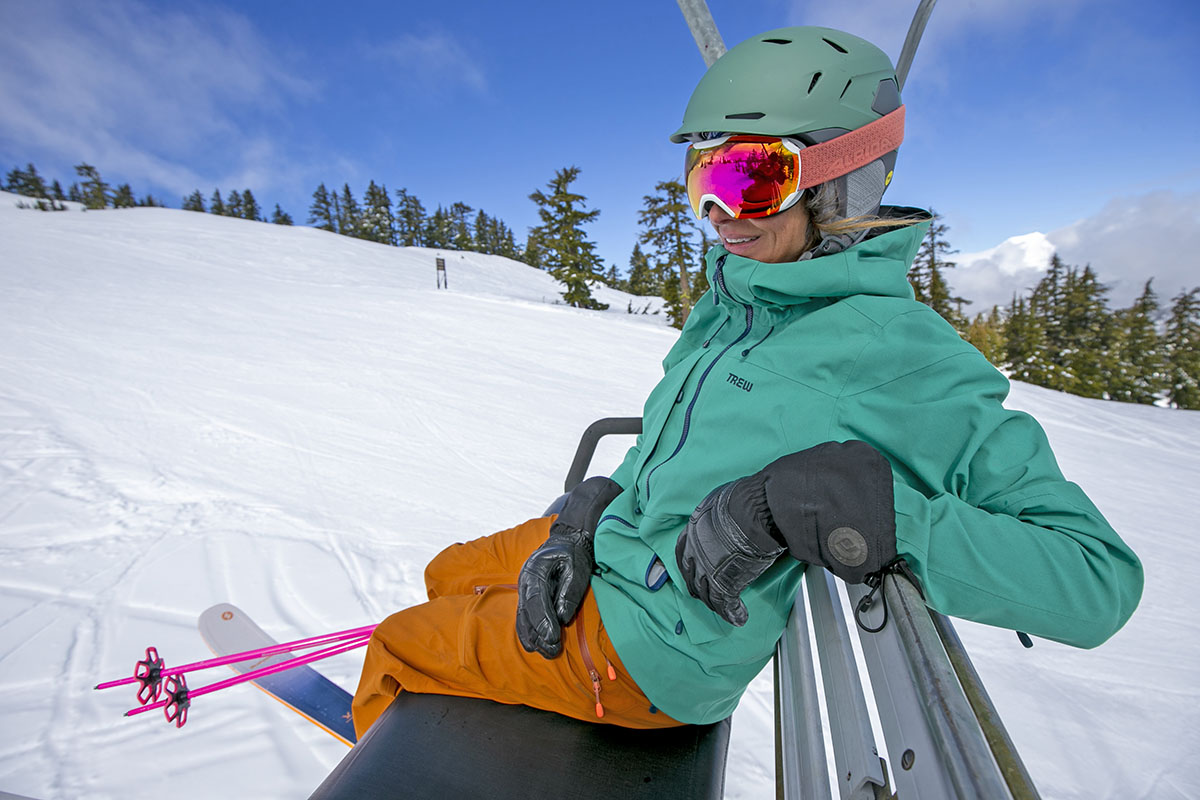
I tested the Stella Jacket Primo for this review, and Trew Gear also makes the Stella Jacket Classic for $80 less. The two designs are largely similar, although the Classic uses a downgraded 3L Classic construction that’s a small step down in waterproofing and durability, checks in an ounce lighter, and is sold in different colorways. On the men’s side, the Cosmic Jacket Primo is the Stella’s counterpart and shares a nearly identical overall construction and feature set, including a removable powder skirt, 16-inch pit zips, a practical storage layout, and an in-house PNW Primo membrane for just 0.5 ounces more (for an in-depth look, see our Cosmic Primo Jacket review). Trew Gear’s men’s Cosmic Jacket Classic rounds out their lineup. That jacket is very similar to the Stella Jacket Classic but weighs an additional 0.5 ounces and, like the women’s Primo compared to the Classic, comes in different colorways.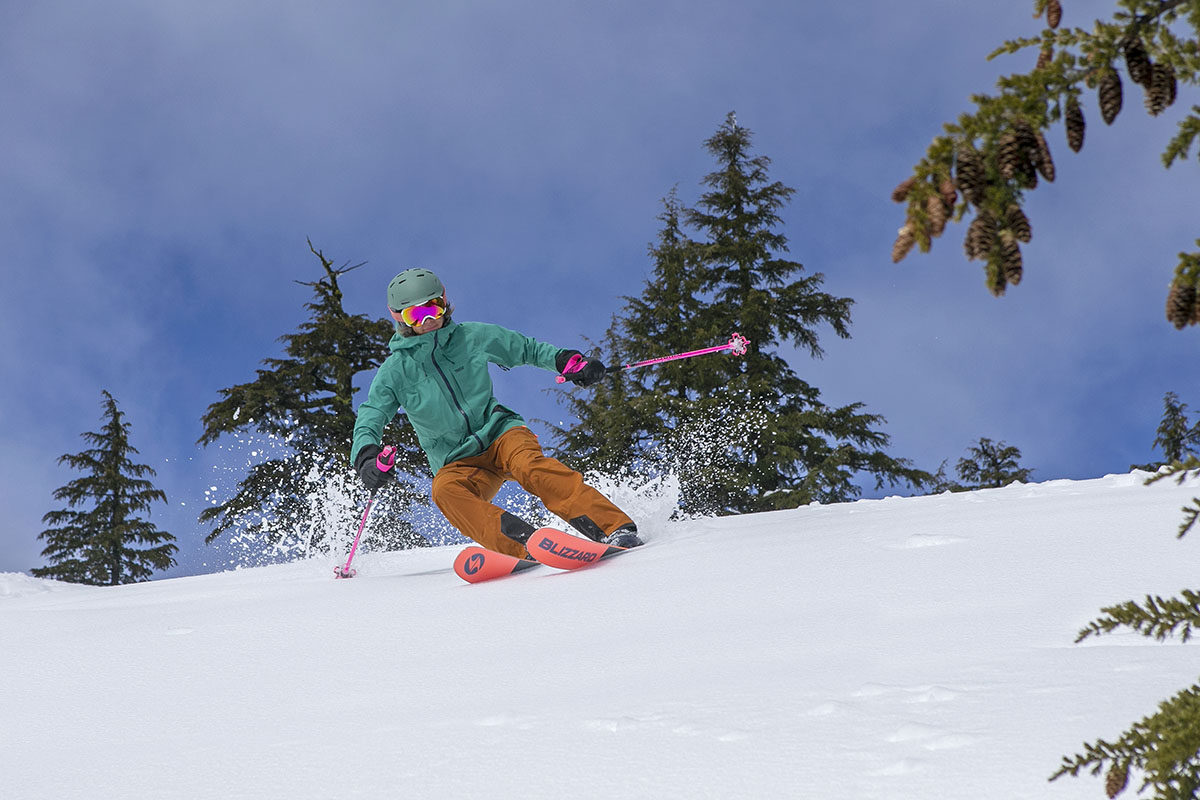
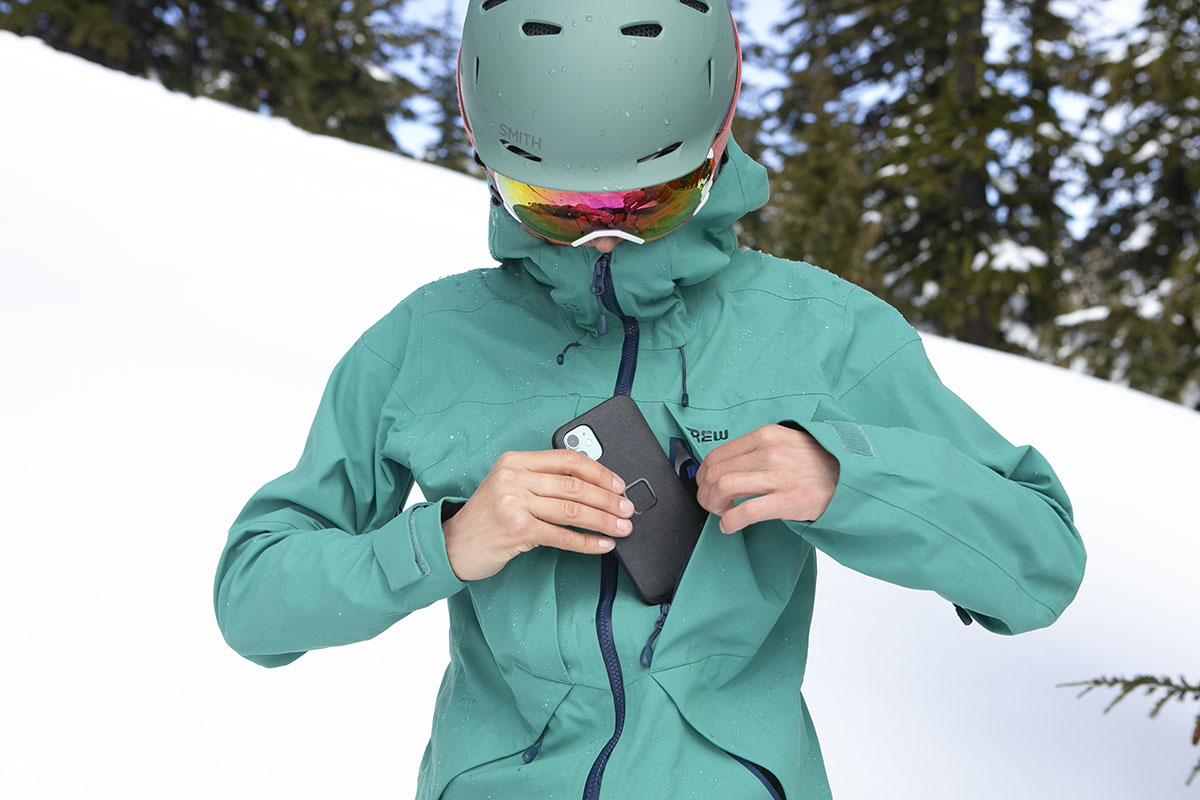
| Jacket | Price | Best For | Waterproof | Weight | Pockets | Recco |
|---|---|---|---|---|---|---|
| Trew Gear Stella Jacket Primo | $499 | Resort/backcountry | 3L Primo | 1 lb. 9 oz. | 7 | Yes |
| Flylow Gear Lucy Jacket | $400 | Backcountry/resort | 3L Tactic | 1 lb. 3.5 oz. | 5 | No |
| Outdoor Research Skytour | $399 | Backcountry | 3L AscentShell | 1 lb. 4.3 oz. | 6 | No |
| Outdoor Research Carbide | $329 | Backcountry/resort | 3L Pertex | 1 lb. 2.8 oz. | 7 | No |
| Black Diamond Recon Stretch | $450 | Backcountry/resort | 3L BD.dry | 1 lb. 7 oz. | 6 | No |
| Backcountry Cottonwoods | $449 | Resort | 3L Gore-Tex | 1 lb. 14 oz. | 7 | No |
The Stella Jacket Primo is a well-built and highly protective resort ski jacket, but it’s a little too heavy and bulky for frequent backcountry use. For 5.5 ounces less, Flylow Gear’s Lucy Jacket offers similar appeal in a slightly more balanced package. In short, the Lucy combines the best attributes of softshell and hardshell designs with a stretchy 3-layer construction and smooth interior that’s highly comfortable. It also gets the clear edge in both breathability and ease of movement for touring, although the emphasis on comfort and stretch does impact the Flylow’s bombproof feel (the Stella is the better pick for particularly wet and nasty days). The Lucy also lacks internal dump pockets for stashing goggles or skins, and the chest pockets were too small to fit a large phone (for more, see our in-depth review here). The Lucy is cheaper and has a similarly sleek and modern aesthetic, but the drawbacks in storage and protection are notable—especially for those who live in wet climates like the Pacific Northwest.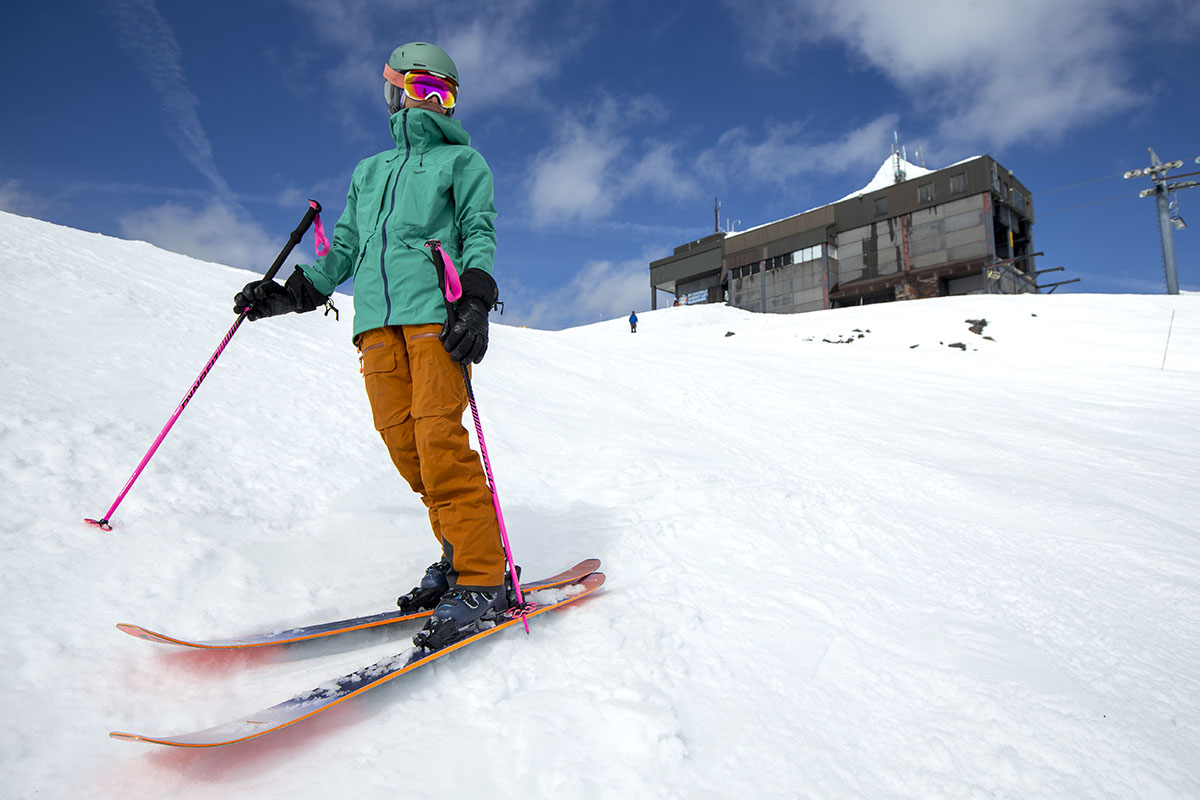
For an even more backcountry-ready option, we love Outdoor Research’s Skytour AscentShell Jacket. Like the Lucy, the Skytour has a stretchy, softshell-like feel thanks to OR’s in-house AscentShell membrane, which is also highly breathable without compromising on wet-weather protection. The feature set lines up well, too, including an adjustable and helmet-compatible hood with a wire brim for deflecting moisture, six well-placed pockets, and pit zips for dumping excess heat. That said, the Skytour forgoes a powder skirt and Recco reflector, and the 40D x 65D shell fabric is a little thin for regular inbounds use. The OR will save you money and 4.7 ounces, but the Stella Jacket Primo is the more hardwearing and reliable option for frequent resort skiers.
For riders who split their time between the front- and backcountry but gravitate mostly toward the latter, Outdoor Research’s Carbide Jacket fits the bill nicely. In this case, OR opted for a 3-layer Pertex Shield construction that offers reliable wet-weather protection in a competitively light (1 lb. 2.8 oz.) package. The drop in weight is largely due to the thin 40D shell fabric, which lacks the toughness required for day-long exposure to the elements and regular inbounds use, but it’s an excellent match for minimalist tours and the occasional resort outing. Importantly, it also packs in all the requisite ski-specific features, including a functional hood, pit zips, a powder skirt, plenty of storage, and even a tricot knit backer for added next-to-skin comfort. Again, resort riders will want to spend up for the more durable Stella Jacket Primo, but the Carbide is a well-priced alternative for those who like to earn their turns most of the time.
Next up is Black Diamond’s Recon Stretch, which is a well-rounded option that excels both inside and outside the ropes. The jacket combines Black Diamond’s proprietary 3-layer BD.dry membrane with a four-way stretch shell, translating to full-on weather protection with little compromise in the way of comfort or mobility. Uphill enthusiasts will love the removable powder skirt and internal mesh drop pockets for storing their skins, while resort-goers will appreciate the healthy storage layout and full suite of premium features. The BD is also a little cheaper and lighter than the Stella Jacket Primo, although we prefer the more freeride-focused styling and fit of the Trew Gear. 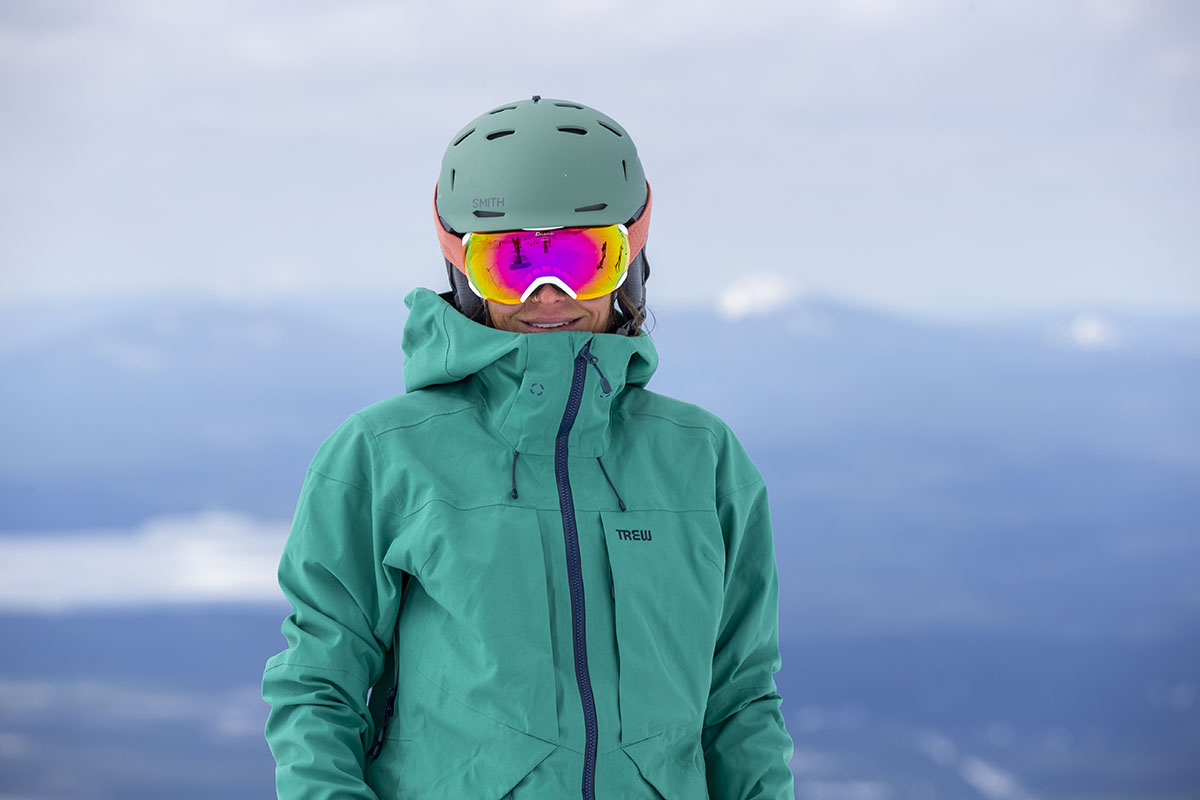
Last but not least, Backcountry’s Cottonwoods Gore-Tex Jacket competes closely with the Stella Jacket Primo in burliness and features. As the brand’s premium resort shell, the Cottonwoods boasts a 3-layer Gore-Tex build that offers great all-around protection, features a burly 70D face fabric that holds up well to rough use, and includes a generous storage layout featuring seven total pockets (the same number as the Stella). Other similarities include an adjustable and helmet-compatible hood, removable powder skirt, and relaxed fit for ease of layering underneath. The Cottonwoods is also a decent value, although the thick build comes with a bump in weight (1 lb. 14 oz.) and has a noticeably stiff feel. For 5 ounces less, the suppler Stella strikes us as worth the price penalty for those who split their time between the resort and backcountry.
If you’re thinking about buying gear that we’ve reviewed on Switchback Travel, you can help support us in the process. Just click on any of the seller links above, and if you make a purchase, we receive a small percentage of the transaction. The cost of the product is the same to you but this helps us continue to test and write about outdoor gear. Thanks and we appreciate your support!
Depending on the seller, most products ship free in the United States on orders of $50 or more. International shipping availability and rates vary by seller. The pricing information on this page is updated hourly but we are not responsible for inaccuracies.